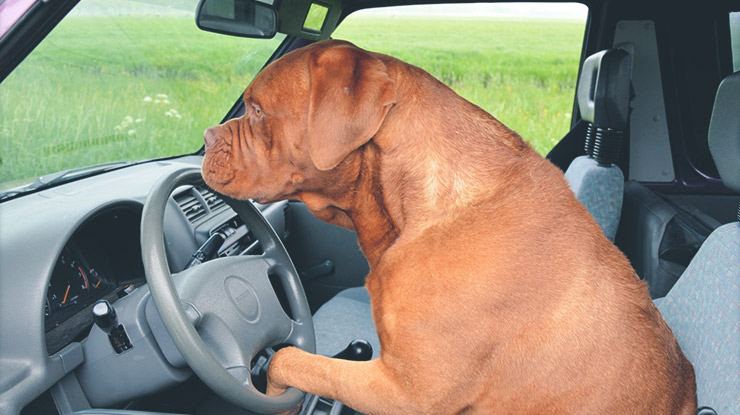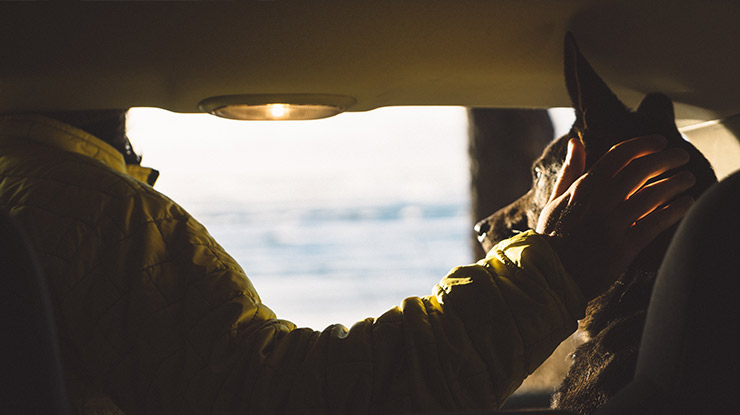
Road Rules: Keeping Your Dog Safe in a Vehicle
Statistics from the National Highway Traffic Safety Administration (NHTSA) showed that 5,687,000 car crashes resulted in a million and half injured people and almost 33,000 fatalities in 2013.
Many of these accidents occurred due to a driver’s poor judgment, such as drunk driving and driving while distracted. Cell phones were noted to be the top distractors, but the distraction of unrestrained pets in a vehicle wasn’t far behind.
These numbers are truly outstanding, and the number of accidents hasn’t seemed to diminish in any significant way.
Other than unrestrained dogs being a distraction to the driver, there are other added dangers with unrestrained pets. At a speed of about 25 mph, an unrestrained dog that weighs 50 pounds becomes a projectile force of 1,500 pounds that lunges forward, harming the dog and potentially the passengers inside the vehicle.
The potential for harm becomes especially alarming if your dog is not just an average-sized dog, but one as large as a Tibetan mastiff, Great Dane, Irish wolfhound or any breed that shares the same weight and size.
Giant dog breeds do not have a specific weight category, but they can weigh anywhere from 110 pounds to over 200 pounds. In car collisions, the projectile force can be four times their weight and sometimes more depending on the car’s speed. As a responsible dog owner, you need to be especially vigilant in keeping your dog safe on the road.
Moreover, you also have to do your research to ensure that the equipment has been properly crash-tested. Some products may be cheap, but you have to make sure that the material used is top quality and up to safety standards, because despite saving money, it may do nothing for the safety of your dog.
So what do you do to ensure that you and your canine companion will be safe on the road? What would be the ideal safety equipment that best suits your dog and your vehicle? Let’s talk about some of the safety equipment that you would typically see out in the market, and the advantages and disadvantages of using them.

Barriers
If you own a car that has a spacious cargo area like a SUV type of car, putting a barrier between the second-row seats and the cargo area is typically a good option.
Barriers usually come in two types. There are steel barriers that are sometimes installed into the car, and there are mesh barriers. Both serve their intended purposes, but steel barriers are more of a commitment because of the instalment. Meanwhile, mesh barriers may offer protection, but may not be as strong as a steel barrier.
The great thing about having a spacious cargo area where your dog can fit is that it allows for better comfort. Obviously, due to their size, larger dogs will require ample space.
When travelling, simply using the same bedding that your dog uses in the house will significantly improve his comfort during car rides. Dog bedding that doesn’t take up too much space would be great in car rides—such as dog bedding for large pets and foldable dog bedding—are great references for the ideal bed.
In the event of a collision, the barrier prevents your dog from becoming a projectile. The main disadvantage of simply using a barrier however is this is not ideal for cars that are convertibles or crossover type cars. These types of cars’ cargo areas aren’t just small, they’re also crumple zones in a collision.

Harnesses
When using a safety harness, the dog will be situated at the second row of the car and away from airbags.
It is highly recommended that a mesh barrier be put between the second row and the driver’s area. A mesh barrier is more ideal, since it encourages better air flow and the additional safety equipment is an added layer of protection in case of a collision.
Take note that cheap harnesses that are not up to quality and safety standards have flooded the market; so again, you must do your due diligence when researching products.
Using a safety harness is ideal for crossover-type cars, but the main disadvantage comes for those with large dogs—the harness takes up a lot of space, which means you won’t be able to fit as many passengers into your car.

Crates
Without a doubt, crates are the safest way to travel. If you have crate trained your dog, he should be more relaxed since the enclosed space is familiar—and the more familiar a dog is with his surroundings, the safer and calmer he will be.
Although these are the safest option, the size that will accommodate your dog, especially a larger dog, may be hard to find. A giant-sized crate will take up a lot of space, and thus, a small car might not be able to fit the crate. For this reason, crates are usually more ideal for bigger cars.
If you are driving a pickup, it can be a bad idea to put your dog in the bed of the truck when traveling. Therefore, a crate that’s properly tethered would be a great alternative.
However, you should only do this if you really have to, and there are some states and countries that do not allow dogs to travel in this way, so you would have to check the laws of the area where you will be traveling first.
In cases like these, a harness and a barrier would be a better alternative than putting the crate at the back.
As responsible pet parents and citizens, we have to be mindful of road safety and what it entails. Doing all the necessary safety precautions is indeed a lot of work, but when it comes to keeping your dog out of harm’s way, you need to remain vigilant.
Let’s all do our part to reduce accidents on the road and make driving safer for everyone.
-----
About the Author: Christy of Doglifestore.com likes to write about whatever tickles her fancy and loves to document the adventures of her fur baby when she's not busy going gaga over their crazy antics.











